A Model for Predicting Energy Usage Pattern Types with Energy Consumption Information According to the Behaviors of Single-Person Households in South Korea
Abstract
:1. Introduction
2. Materials and Methods
2.1. Research Process
- Step 1: Build 5193 EUP datasets by redefining 5193 “Korean Time Use Survey (KTUS)” data points [14] through codes related to energy consumption.
- Step 2: Derive EUP types by performing K-modes clustering analysis with the EUP dataset built in Step 1.
- Step 3: Create 5193 “occupant schedules” to become inputs into EnergyPlus using the EUP dataset built in Step 1. Implement representative residential environments of Korean single-person households, and extract 5193 points of “energy consumption data” based on occupant behaviors through energy simulation.
- Step 4: Provide an “Energy Consumption Information” model for three items (total, cooling, and heating) for each type through a Gaussian process with the EUP types and energy consumption data, which are the results of Steps 2 and 3, as input.
- Step 5: Train the SVM model to predict EUP types through 5193 occupant features and EUPs, and verify the suitability of the model through the test process of the trained predictive model.
2.2. Generating EUP Datasets from the Korean Time Use Survey
2.3. Deriving EUP Types and an Energy Consumption Information Model for Each Type
2.3.1. K-Modes Clustering
- Select k random cluster centers.
- Calculate the distance between each object and cluster center, and allocate each object to the closest cluster center. Allocate every object to clusters, and move the cluster center in the direction for which the distance between each object and cluster center becomes minimized.
- Compare the center of the moved cluster with the previous center. If the result is different, return to Step 2 and repeat. The analysis is stopped if the same result value, when compared with the previous center, is generated.
2.3.2. EnergyPlus
- The input data for “Environment” included the location, which was based on the latitude and longitude of the target site, Greenwich Mean Time, surrounding city environment, and weather data. This was the external environment information that affected the building energy. For weather data, which was not provided by EnergyPlus, the “Korea standard weather data” from Seoul were used [24].
- “Building Information” included a 3D model, material, and the composition of the simulation object. To build a simulation environment that was similar to the actual environment, we received the energy savings plan and drawings of the S Happy House from LH.
- For the “Cooling and Heating System”, a wall-mounted air conditioner and floor heating system were applied [25]. The cooling and heating temperatures for a comfortable indoor environment were set as 20 °C and 26 °C, respectively, by referring to the Certification Standard for Building Energy Efficiency Rating and Zero Energy Building [26]. Water was delivered from an external source, but hot water was heated through an individual boiler.
- “Applications” include electric lights, refrigerator, TV, computer, washing machine, and gas range. For the power standards of these applications, the “Survey Of Household Appliance Penetration And Household Power Consumption” was referenced [16].
- “Occupant Schedules” corresponds to every schedule used for simulations based on the occupant’s behaviors. In this study, 5193 data points obtained through the KTUS were used.
2.3.3. Gaussian Process Regression
2.4. Methodology for Predicting EUP Types Used by the SVM
3. Results and Discussion
Deriving the EUP Types and Analysis of Occupant Features through K-Modes Clustering
- Type 1 was a cluster that mainly consists of people aged 65 or older (51.7%) with low incomes. They were mainly involved in outside activities between 04:30 and 09:00, and in indoor activities in the residence at other times.
- Type 2 had the highest ratios of household members who are 65 or older (66.0%), female (68.8%), had monthly incomes less than 1 million won (75.8%), and had care needs (65.78%). They had almost no outside activities or hobbies. Their main space of activity was their residence.
- Type 3 had the highest ratio of economic activities (81.4%), and their daily work started in the afternoon, after 13:00. After their economic activities were finished in the late evening, they mainly slept in their residence between 04:00 and 13:00. Besides sleeping, their activities related to energy consumption were few, and their living patterns were irregular.
- Type 4 spent a similar amount of time in the residence as Type 1. Their genders, monthly incomes, and jobs were similar, but their age was different. The time slot for the main outside activities of Type 4 was 18:00 to 22:30. They spent a high percentage of time in hobby activities in their residence.
- Type 5 had a sleeping time period similar to that of Type 3, but after sleeping they mainly spent time in their residence enjoying hobbies. They went out in the evening between 22:00 and 08:00.
- Type 6 had a high percentage of youth who were active in economic and outside activities, with the lowest ratio of people aged 65 or older (9.0%). Furthermore, they spent the shortest amount of time in their residences. The main activity in the residence was personal hygiene, and they had the least amount of time spent on other activities.
- Type 7 comprised 2074 out of the 5193 data points. This seemed to be the living pattern type of general office workers. However, based on the percentage of those 65 years or older (45.4%) and without work (51.2%), this type also included people who spent their personal time mainly outside their residence, besides office workers.
4. Conclusions
Supplementary Materials
Author Contributions
Funding
Acknowledgments
Conflicts of Interest
Appendix A



References
- Nejat, P.; Jomehzadeh, F.; Taheri, M.M.; Gohari, M.; Majid, M.Z.A.J.R. A global review of energy consumption, CO2 emissions and policy in the residential sector (with an overview of the top ten CO2 emitting countries). Renew. Sustain. Energy Rev. 2015, 43, 843–862. [Google Scholar] [CrossRef]
- Conti, J.; Holtberg, P.; Diefenderfer, J.; LaRose, A.; Turnure, J.T.; Westfall, L. International Energy Outlook 2016 with Projections to 2040; USDOE Energy Information Administration (EIA), Office of Energy Analysis: Washington, DC, USA, 2016.
- Guo, F.; Akenji, L.; Schroeder, P.; Bengtsson, M.J.E. Static analysis of technical and economic energy-saving potential in the residential sector of Xiamen city. Energy 2018, 142, 373–383. [Google Scholar] [CrossRef]
- Hoicka, C.E.; Parker, P.J.E.E. Assessing the adoption of the house as a system approach to residential energy efficiency programs. Energy Effic. 2018, 11, 295–313. [Google Scholar] [CrossRef]
- Gonzalez, J.M.; Pouresmaeil, E.; Canizares, C.A.; Bhattacharya, K.; Mosaddegh, A.; Solanki, B.V. Smart Residential Load Simulator for Energy Management in Smart Grids. IEEE Trans. Ind. Electron. 2018, 66, 1443–1452. [Google Scholar]
- Menezes, A.C.; Cripps, A.; Bouchlaghem, D.; Buswell, R.J.A.E. Predicted vs. actual energy performance of non-domestic buildings: Using post-occupancy evaluation data to reduce the performance gap. Appl. Energy 2012, 97, 355–364. [Google Scholar] [CrossRef] [Green Version]
- Ouyang, J.; Hokao, K.J.E. Energy-saving potential by improving occupants’ behavior in urban residential sector in Hangzhou City, China. Energy Build. 2009, 41, 711–720. [Google Scholar] [CrossRef]
- Guerra-Santin, O.; Bosch, H.; Budde, P.; Konstantinou, T.; Boess, S.; Klein, T.; Silvester, S.J.E.E. Considering user profiles and occupants’ behaviour on a zero energy renovation strategy for multi-family housing in the Netherlands. Energy Effic. 2018, 1–24. [Google Scholar] [CrossRef]
- Brounen, D.; Kok, N.; Quigley, J.M.J.E.E.R. Residential energy use and conservation: Economics and demographics. Eur. Econ. Rev. 2012, 56, 931–945. [Google Scholar] [CrossRef] [Green Version]
- Amasyali, K.; El-Gohary, N.M.J.R.; Reviews, S.E. A review of data-driven building energy consumption prediction studies. Renew. Sustain. Energy Rev. 2018, 81, 1192–1205. [Google Scholar] [CrossRef]
- Yu, B.; Wei, Y.-M.; Kei, G.; Matsuoka, Y.J.N.E. Future scenarios for energy consumption and carbon emissions due to demographic transitions in Chinese households. Nat. Energy 2018, 3, 109–118. [Google Scholar] [CrossRef]
- Statistics Korea. Population and Housing Census; Statistics Korea, Ed.; Statistics Korea: Seoul, Korea, 2015.
- Lee, S.G.; Lee, S.I.; Na, I.G. A Study on Improvement Mesures for the National Energy Saving and Efficiency Improvement System; Korea Energy Economics Institute; KEEI: Ulsan, Korea, 31 December 2008. [Google Scholar]
- Statistics Korea. 2014 Korea Time Use Survey; Statistics Korea, Ed.; Micro Intergreted Service: Seoul, Korea, 2015.
- Statistics Korea. Guidelines for Users of 2014 Korean Time Use Survey; Statistics Korea, Ed.; Statistics Korea: Seoul, Korea, 2016.
- Exchange, K.P. A Survey of Hosehold Appliance Penetration and Household Power Consumption Patterns; Statistics Korea, Ed.; Statistics Korea: Seoul, Korea, 2013.
- MacQueen, J. Some methods for classification and analysis of multivariate observations. In Proceedings of the Fifth Berkeley Symposium on Mathematical Statistics and Probability, Berkeley, CA, USA, 21 June–18 July 1965; pp. 281–297. [Google Scholar]
- Huang, Z.; Ng, M.K. A note on k-modes clustering. J. Classif. 2003, 20, 257–261. [Google Scholar] [CrossRef]
- Huang, Z. Extensions to the k-means algorithm for clustering large data sets with categorical values. Data Min. Knowl. Discov. 1998, 2, 283–304. [Google Scholar] [CrossRef]
- Crawley, D.B.; Lawrie, L.K.; Winkelmann, F.C.; Buhl, W.F.; Huang, Y.J.; Pedersen, C.O.; Strand, R.K.; Liesen, R.J.; Fisher, D.E.; Witte, M.J.J.E.; et al. EnergyPlus: Creating a new-generation building energy simulation program. Energy Build. 2001, 33, 319–331. [Google Scholar] [CrossRef]
- Zhou, X.; Hong, T.; Yan, D. Comparison of HVAC system modeling in EnergyPlus, DeST and DOE-2.1 E. In Building Simulation; Springer: Berlin/Heidelberg, Germany, 2014; pp. 21–33. [Google Scholar]
- Ministry of Land, Infrastructure and Transport. Introduction of Happy House. Available online: www.molit.go.kr/happyhouse/info.jsp (accessed on 30 January 2018).
- Jang, H.; Kang, J.J.E. An energy model of high-rise apartment buildings integrating variation in energy consumption between individual units. Energy Build. 2018, 158, 656–667. [Google Scholar] [CrossRef]
- The Korean Solar Energy Society; KIAEBS. Korean Standard Weather Data; The Korean Solar Energy Society, KIAEBS, Eds.; The Korean Solar Energy Society; KIAEBS: Seoul, Korea, 2015. [Google Scholar]
- US DOE. Getting Started with Energy Plus; US Department of Energy: Washington, DC, USA, 2009.
- Ministry of Land, Infrastructure and Transport. Standards for Building Energy Efficiency Rating and Zero Energy Building Certification; Ministry of Land, Infrastructure and Transport, Ed.; Ministry of Land, Infrastructure and Transport: Sejong, Korea, 2017.
- Williams, C.K.; Rasmussen, C.E. Gaussian processes for regression. In Advances in Neural Information Processing Systems; NIPS: Montreal, QC, Canada, 1996; pp. 514–520. [Google Scholar]
- Yoon, Y.R.; Moon, H.J.J.E. Energy consumption model with energy use factors of tenants in commercial buildings using Gaussian process regression. Energy Build. 2018, 168, 215–224. [Google Scholar] [CrossRef]
- Heo, Y.; Choudhary, R.; Augenbroe, G.J.E. Calibration of building energy models for retrofit analysis under uncertainty. Energy Build. 2012, 47, 550–560. [Google Scholar] [CrossRef]
- Kim, Y.-J.; Park, C.-S. Gaussian process model for real-time optimal control of chiller system. J. Archit. Inst. Korea Plan. Des. 2014, 30, 211–220. [Google Scholar] [CrossRef]
- Nghiem, T.X.; Jones, C.N. Data-driven demand response modeling and control of buildings with gaussian processes. In Proceedings of the 2017 American Control Conference (ACC), Seattle, WA, USA, 24–26 May 2017; pp. 2919–2924. [Google Scholar]
- Sheng, H.; Xiao, J.; Cheng, Y.; Ni, Q.; Wang, S. Short-term solar power forecasting based on weighted Gaussian process regression. IEEE Trans. Ind. Electron. 2018, 65, 300–308. [Google Scholar] [CrossRef]
- Rasmussen, C.E. Gaussian processes in machine learning. In Advanced Lectures on Machine Learning; Springer: Berlin, Germany, 2004; pp. 63–71. [Google Scholar]
- Heo, Y.; Zavala, V.M.J.E. Gaussian process modeling for measurement and verification of building energy savings. Energy Build. 2012, 53, 7–18. [Google Scholar] [CrossRef]
- Bhinge, R.; Biswas, N.; Dornfeld, D.; Park, J.; Law, K.H.; Helu, M.; Rachuri, S. An intelligent machine monitoring system for energy prediction using a Gaussian Process regression. In Proceedings of the 2014 IEEE International Conference on Big Data (Big Data), Washington, DC, USA, 27–30 October 2014; pp. 978–986. [Google Scholar]
- Blum, M.; Riedmiller, M.J.P. Electricity demand forecasting using Gaussian processes. Power 2013, 10, 104. [Google Scholar]
- Manfren, M.; Aste, N.; Moshksar, R. Calibration and uncertainty analysis for computer models—A meta-model based approach for integrated building energy simulation. Appl. Energy 2013, 103, 627–641. [Google Scholar] [CrossRef]
- The MathWorks, Inc. Statistics and Machine Learning Toolbox™ User’s Guide; Matlab: Natick, MA, USA, 2018. [Google Scholar]
- Huang, J.; Lu, J.; Ling, C.X. Comparing naive Bayes, decision trees, and SVM with AUC and accuracy. In Proceedings of the Third IEEE International Conference on Data Mining, Melbourne, FL, USA, 22 November 2003; p. 553. [Google Scholar]
- Noble, W.S. What is a support vector machine? Nat. Biotechnol. 2006, 24, 1565–1567. [Google Scholar] [CrossRef] [PubMed]
- Al-Mumin, A.; Khattab, O.; Sridhar, G.J.E. Occupants’ behavior and activity patterns influencing the energy consumption in the Kuwaiti residences. Energy Build. 2003, 35, 549–559. [Google Scholar] [CrossRef]
- Huebner, G.; Shipworth, D.; Hamilton, I.; Chalabi, Z.; Oreszczyn, T. Understanding electricity consumption: A comparative contribution of building factors, socio-demographics, appliances, behaviours and attitudes. Appl. Energy 2016, 177, 692–702. [Google Scholar] [CrossRef] [Green Version]
- Kavousian, A.; Rajagopal, R.; Fischer, M.J.E. Determinants of residential electricity consumption: Using smart meter data to examine the effect of climate, building characteristics, appliance stock, and occupants’ behavior. Energy 2013, 55, 184–194. [Google Scholar] [CrossRef]
- Fong, W.-K.; Matsumoto, H.; Lun, Y.-F.; Kimura, R. Influences of indirect lifestyle aspects and climate on household energy consumption. J. Asian Archit. Build. Eng. 2007, 6, 395–402. [Google Scholar] [CrossRef]
- Jung, J.; Yi, C.; Lee, S. An Integrative Analysis of the Factors Affecting the Household Energy Consumption in Seoul. J. Korea Plan. Assoc. 2015, 50, 75–94. [Google Scholar] [CrossRef]
- Noh, S.C.; Lee, H.Y. An Analysis of the Factor Affecting the Energy Consumption of the Household in Korea. J. Korea Plan. Assoc. 2013, 48, 295–312. [Google Scholar]
- Gi, K.; Sano, F.; Hayashi, A.; Tomoda, T.; Akimoto, K. A global analysis of residential heating and cooling service demand and cost-effective energy consumption under different climate change scenarios up to 2050. Mitig. Adapt. Strateg. Glob. Chang. 2018, 23, 51–79. [Google Scholar] [CrossRef]
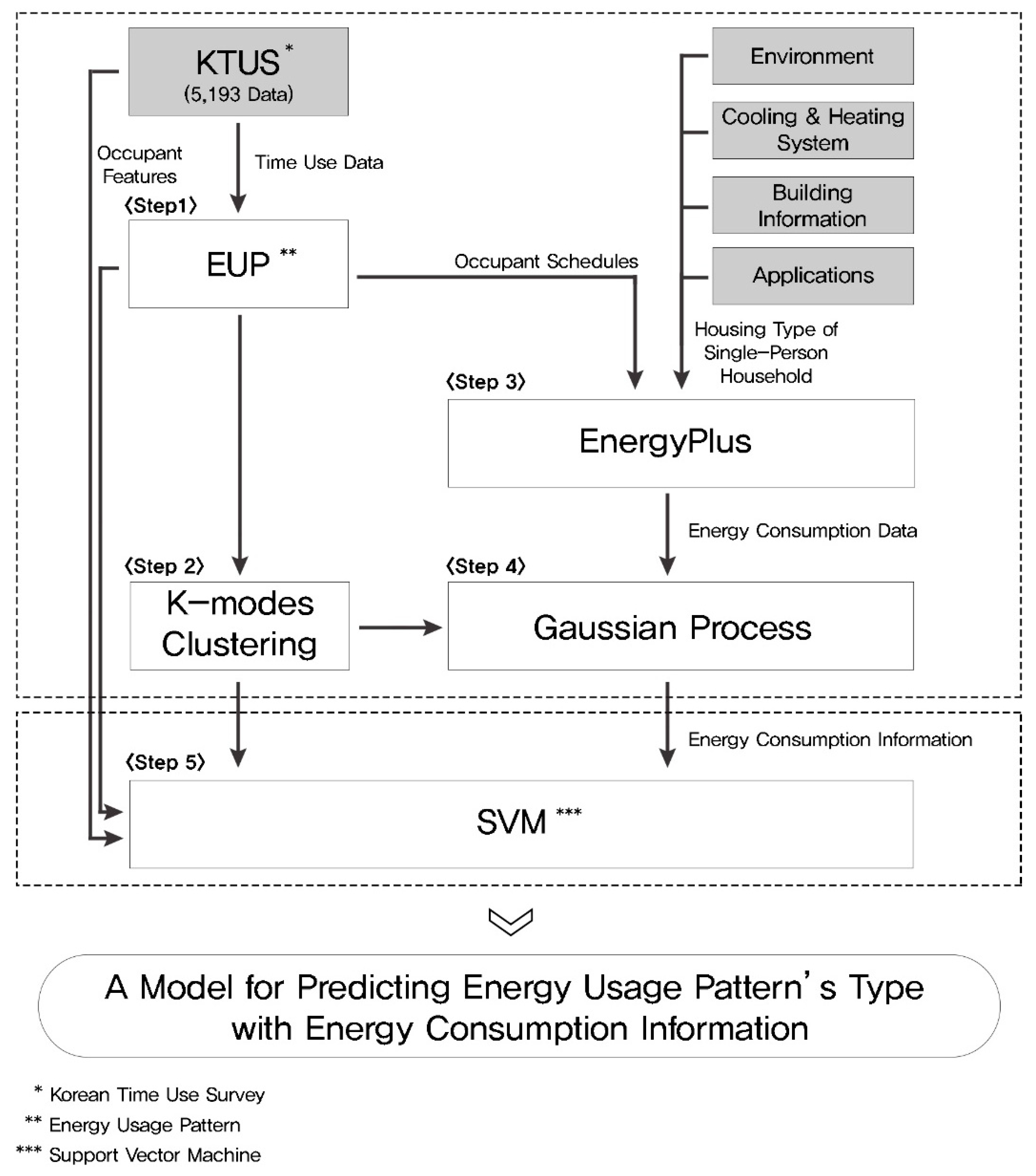


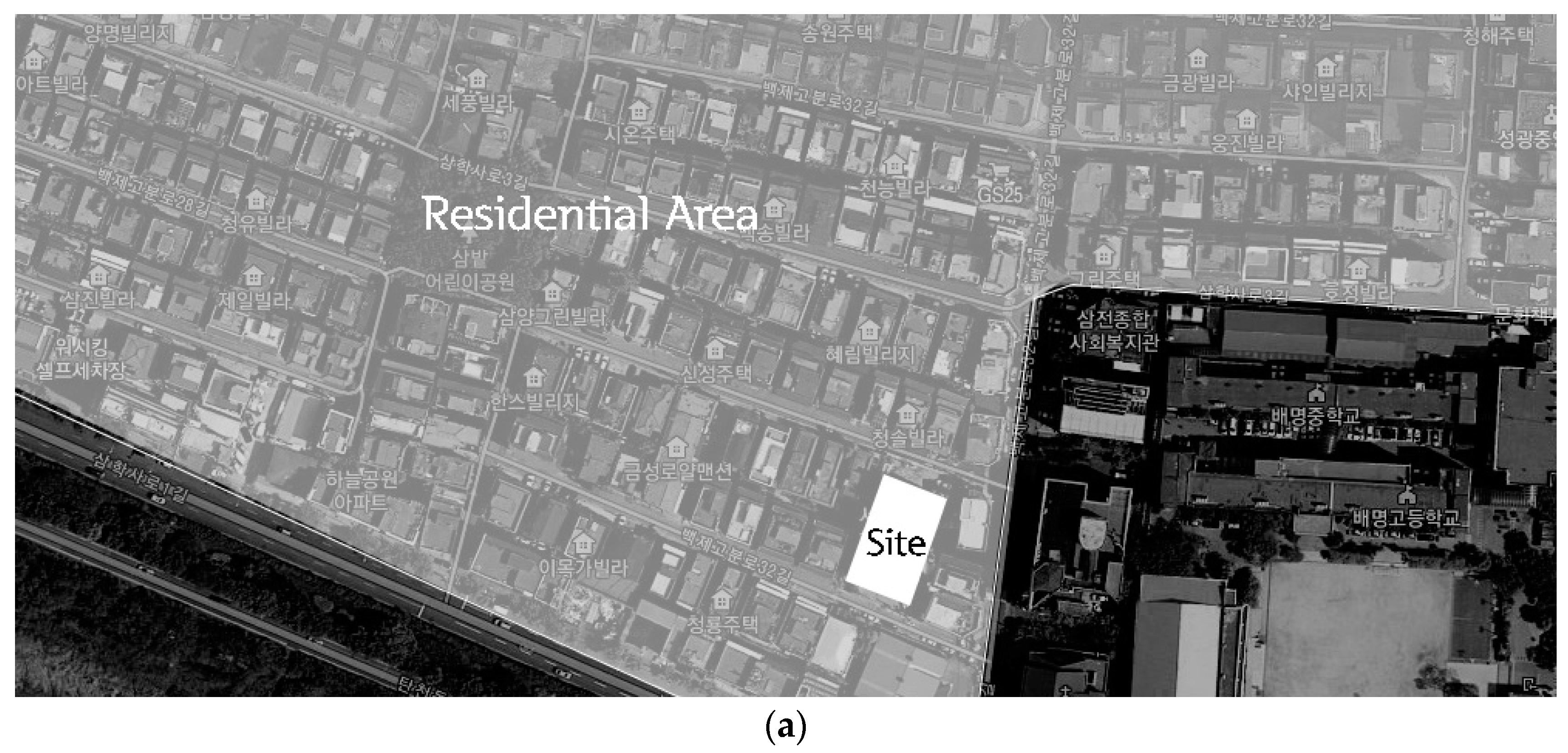
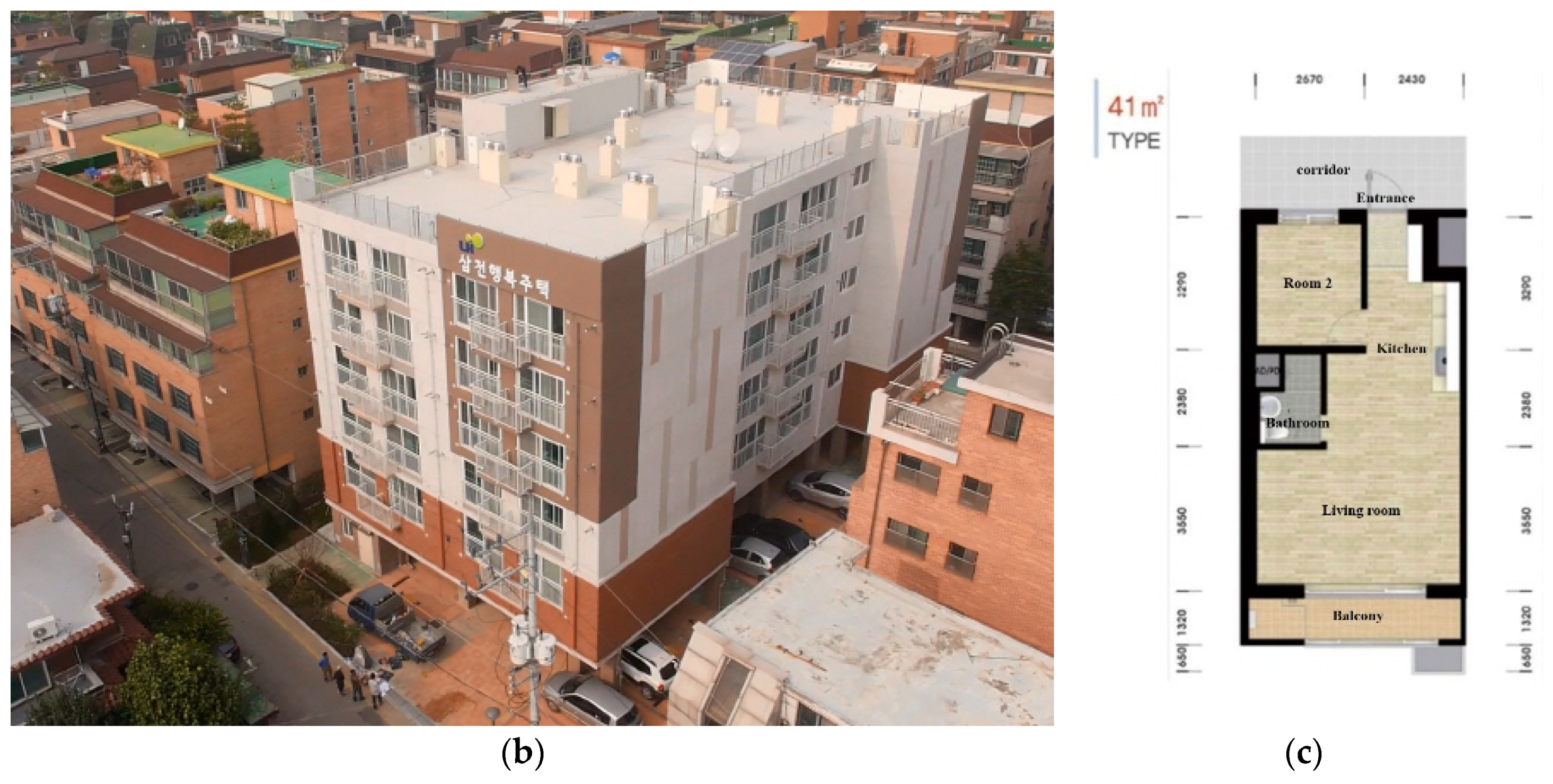
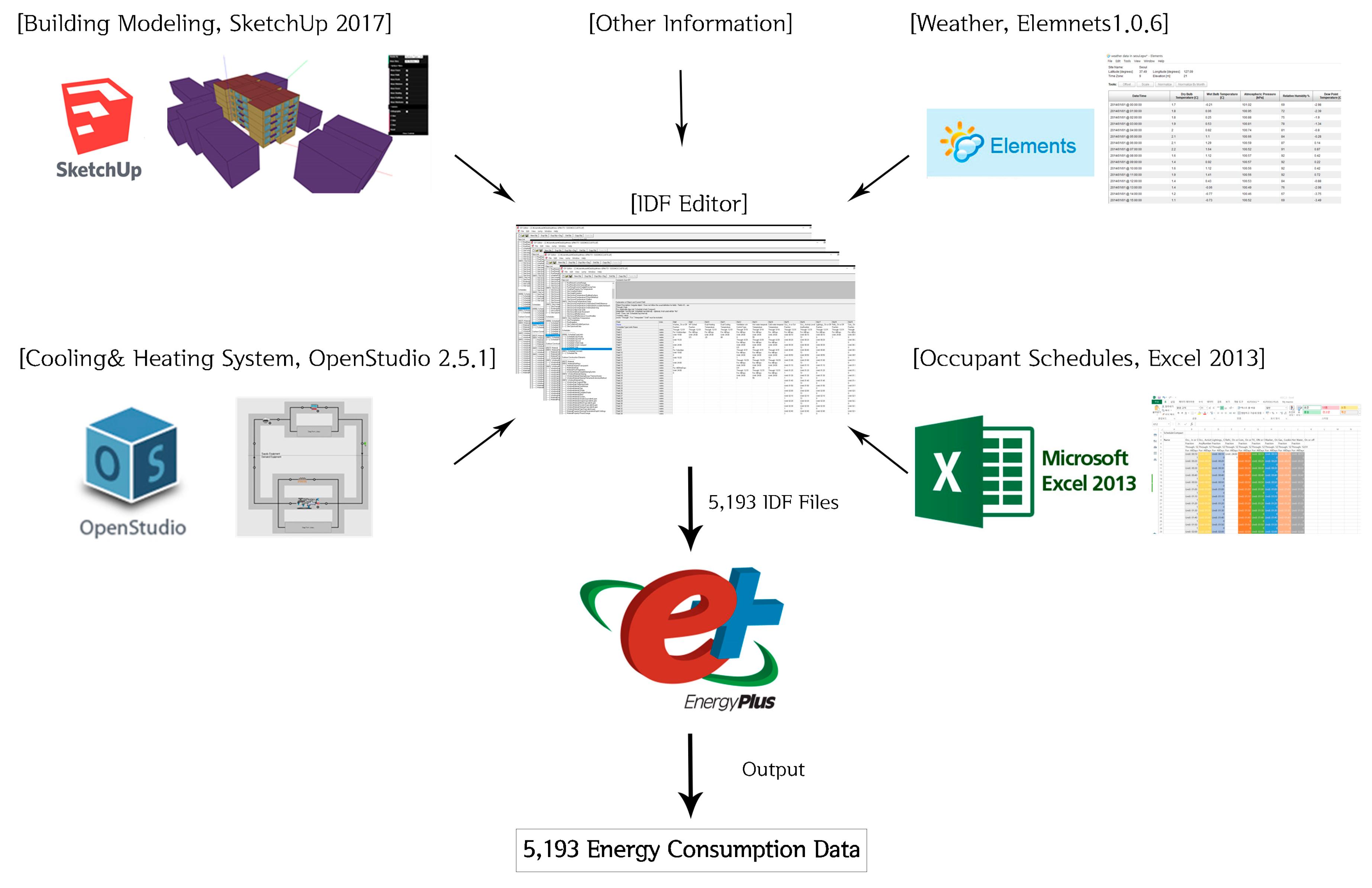



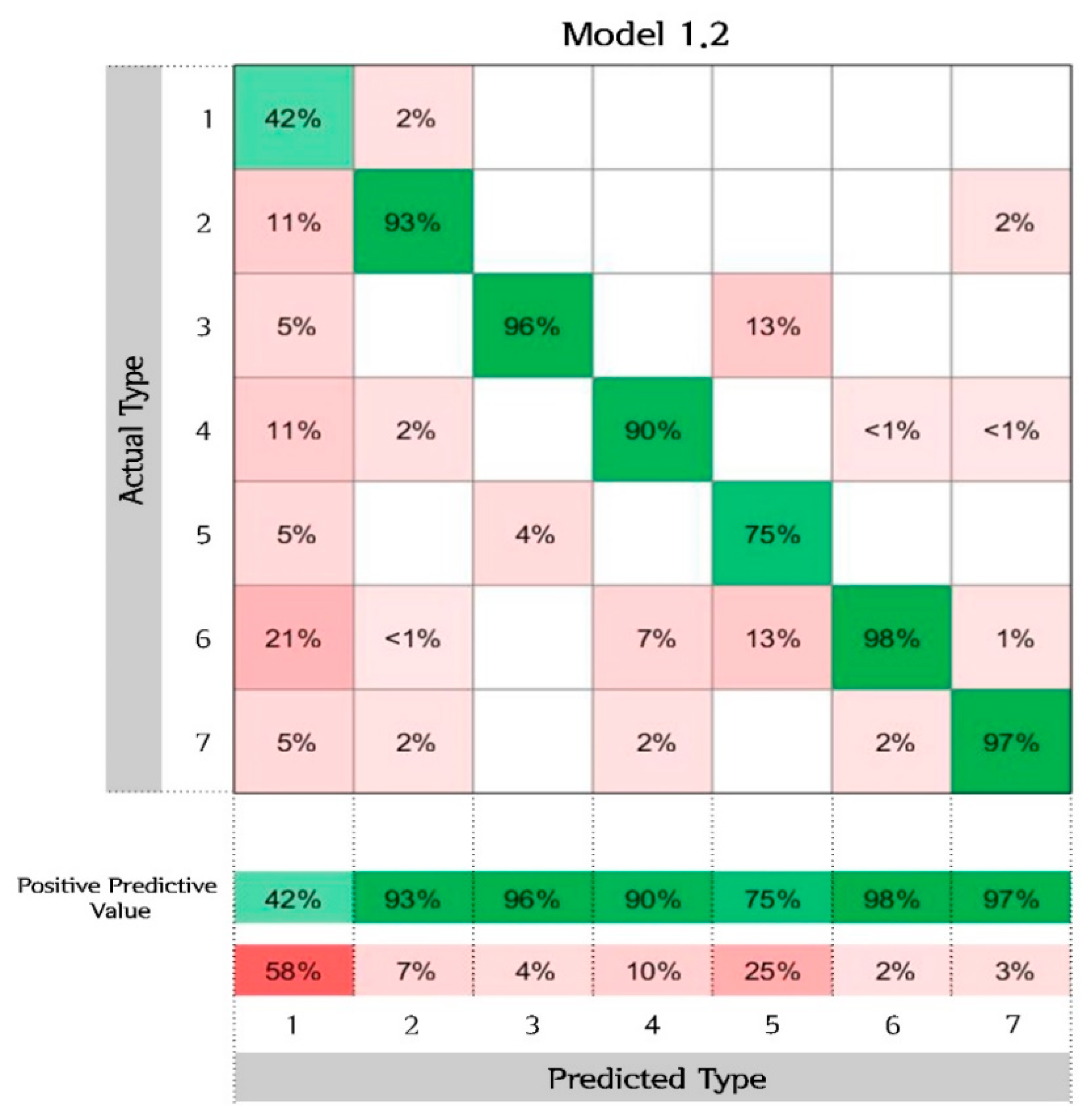
| Electricity | Gas | Energy Consumption Behavior | |||||
|---|---|---|---|---|---|---|---|
| Lighting | Computer | TV | Washing Machine | Refrigerator | Gas Range | Hot Water | EUP Codes |
| ✓ | A1, S1 | ||||||
| ✓ | ✓ | ✓ | O1 | ||||
| ✓ | ✓ | ✓ | L1 | ||||
| ✓ | ✓ | ✓ | L1 | ||||
| ✓ | ✓ | ✓ | L2 | ||||
| ✓ | ✓ | ✓ | C1 | ||||
| ✓ | ✓ | ✓ | G1, D1 | ||||
| Household No. | Time Step 1 (00:00–00:10) | Time Step 2 (00:10–00:20) | Time Step 3 (00:20–00:30) | ··· | Time Step 143 (23:40–23:50) | Time Step 144 (23:50–24:00) |
|---|---|---|---|---|---|---|
| 1 | S1 | S1 | O1 | ··· | G1 | A1 |
| 2 | G1 | G1 | S1 | ··· | L1 | L1 |
| 3 | A1 | A1 | A1 | ··· | S1 | S1 |
| ··· | ··· | ··· | ··· | ··· | ··· | ··· |
| 5192 | A1 | O1 | O1 | ··· | S1 | S1 |
| 5193 | C1 | C1 | L2 | ··· | A1 | A1 |
| EnergyPlus Input Items | Details | Used Tools | |
|---|---|---|---|
| Environment | Location | Seoul Latitude: 37.49 Longitude: 127.09 Time zone: GMT + 9 | Elements1.0.6 |
| Weather | Standard weather data in Seoul | ||
| Building Information | 3D Modeling | S Happy House | SketchUp2017 OpenStudio2.5.1 IDF Editor |
| Material | Glass, Concrete, EPS, etc. | ||
| Construction | External · Internal wall External · Internal window Floor, Roof, Door etc. | ||
| Cooling and Heating Systems | Ductless air-conditioning | Set point: 26 °C | OpenStudio2.5.1 IDF Editor |
| Low temperature radiant system | Set point: 20 °C | ||
| Applications | Lighting | 25 W * 4 ea | IDF Editor |
| Refrigerator | 40.6 W * 1 ea | ||
| TV | 130.6 W * 1 ea | ||
| Computer | 255.9 W * 1 ea | ||
| Washing machine | 242.8 W * 1 ea | ||
| Gas range | 2100 W * 1 ea | ||
| Hot water | 3 ea | ||
| Occupant Schedule | Activity level | 5193 schedules based on EUP data (time step: 10 min) | Excel 2013 IDF Editor |
| Applications Operation | |||
| SVM Type | Model No. | Kernel Function | Kernel Scale Mode | Multiclass Method |
|---|---|---|---|---|
| Linear SVM | 1.1 | Linear kernel | Auto * | One-vs-One ** |
| Quadratic SVM | 1.2 | Quadratic kernel | Auto * | |
| Cubic SVM | 1.3 | Cubic kernel | Auto * | |
| Fine Gaussian SVM | 1.4 | Gaussian kernel | 3.1 | |
| Medium Gaussian SVM | 1.5 | Gaussian kernel | 12 | |
| Coarse Gaussian SVM | 1.6 | Gaussian kernel | 49 |
| Household No. | Occupant Features | EUP Data | Type | ||||||
|---|---|---|---|---|---|---|---|---|---|
| Age | Gender | Income | Working | Care Needs | Time1 | ··· | Time144 | ||
| ··· | |||||||||
| 1 | 42 | woman | 3 | yes | no | S1 | ··· | A1 | 6 |
| 2 | 67 | woman | 1 | no | no | G1 | ··· | L1 | 7 |
| 3 | 70 | man | 1 | no | yes | A1 | ··· | S1 | 2 |
| ··· | ··· | ··· | ··· | ··· | ··· | ··· | ··· | ··· | ··· |
| 5192 | 34 | man | 2 | yes | no | A1 | ··· | S1 | 3 |
| 5193 | 25 | man | 1 | yes | no | C1 | ··· | A1 | 4 |
| Type | Age | Gender | Income (Unit: 10,000 w) | Working | Care Needs | ||||
|---|---|---|---|---|---|---|---|---|---|
| Type 1 (60 persons) | ~30 31~50 51~64 65~ | 7 (11.7) 10 (16.7) 12 (20.7) 31 (51.7) | M W | 28 (46.7) 32 (53.3) | ~100 100~200 200~300 300~400 400~500 500~ | 31 (51.7) 14 (23.3) 9 (15.0) 3 (5.0) 3 (5.0) 0 (0.0) | Y N | 36 (60.0) 24 (40.0) | 2 (1.07) |
| Type 2 (1422 persons) | ~30 31~50 51~64 65~ | 71 (5.0) 143 (10.1) 270 (19.0) 938 (66.0) | M W | 444 (31.2) 978 (68.8) | ~100 100~200 200~300 300~400 400~500 500~ | 1078 (75.8) 219 (15.4) 60 (4.2) 32 (2.3) 13 (0.9) 20 (1.4) | Y N | 283 (19.9) 1139 (80.1) | 123 (65.78) |
| Type 3 (161 persons) | ~30 31~50 51~64 65~ | 43 (26.7) 66 (41.0) 37 (23.0) 15 (9.3) | M W | 94 (58.4) 67 (41.6) | ~100 100~200 200~300 300~400 400~500 500~ | 42 (26.1) 53 (32.9) 50 (31.1) 8 (5.0) 5 (3.1) 3 (1.9) | Y N | 131 (81.4) 30 (18.6) | 4 (2.14) |
| Type 4 (176 persons) | ~30 31~50 51~64 65~ | 79 (44.9) 62 (35.2) 14 (8.0) 21 (11.9) | M W | 87 (49.4) 89 (50.6) | ~100 100~200 200~300 300~400 400~500 500~ | 85(48.3) 47 (26.7) 33 (18.8) 7 (4.0) 2 (1.1) 2 (1.1) | Y N | 101 (57.4) 75 (42.6) | 2 (1.07) |
| Type 5 (33 persons) | ~30 31~50 51~64 65~ | 15 (45.5) 12 (36.4) 2 (6.1) 4 (12.1) | M W | 14 (42.4) 19 (57.6) | ~100 100~200 200~300 300~400 400~500 500~ | 7 (21.2) 6 (18.2) 12 (36.4) 2 (6.1) 2 (6.1) 4 (12.1) | Y N | 31 (93.9) 2 (6.1) | 2 (1.07) |
| Type 6 (1267 persons) | ~30 31~50 51~64 65~ | 384 (30.3) 500 (39.5) 269 (21.2) 114 (9.0) | M W | 673 (53.1) 594 (46.9) | ~100 100~200 200~300 300~400 400~500 500~ | 325 (25.7) 425 (33.5) 309 (24.4) 104 (8.2) 50 (3.9) 54 (4.3) | Y N | 1004 (79.2) 263 (20.8) | 7 (3.74) |
| Type 7 (2074 persons) | ~30 31~50 51~64 65~ | 206 (9.9) 384 (18.5) 543 (26.2) 941 (45.4) | M W | 731 (35.2) 1343 (64.8) | ~100 100~200 200~300 300~400 400~500 500~ | 1180 (56.9) 476 (23.0) 237 (11.4) 71 (3.4) 47 (2.3) 63 (3.0) | Y N | 1012 (48.8) 1062 (51.2) | 47 (25.13) |
| Type 1 | Type 2 | Type 3 | Type 4 | Type 5 | Type 6 | Type 7 | |
|---|---|---|---|---|---|---|---|
| Lighting | 2 | 1 | 6 | 3 | 5 | 7 | 4 |
| Equipment | 2 | 1 | 7 | 4 | 5 | 6 | 3 |
| Cooling | 2 | 1 | 6 | 3 | 4 | 7 | 5 |
| Heating | 2 | 1 | 7 | 4 | 5 | 6 | 3 |
| Total | 2 | 1 | 7 | 4 | 5 | 6 | 3 |
| SVM Type | Model No. | Prediction Speed (No. of Observations Per s) | Training Time (s) | Accuracy (%) |
|---|---|---|---|---|
| Linear SVM | 1.1 | ~1900 | 7.6457 | 94.0% |
| Quadratic SVM | 1.2 | ~1300 | 8.1307 | 95.0% |
| Cubic SVM | 1.3 | ~1400 | 8.4946 | 94.5% |
| Fine Gaussian SVM | 1.4 | ~170 | 57.533 | 51.6% |
| Medium Gaussian SVM | 1.5 | ~1300 | 9.383 | 93.8% |
| Coarse Gaussian SVM | 1.6 | ~1000 | 12.078 | 91.0% |
© 2019 by the authors. Licensee MDPI, Basel, Switzerland. This article is an open access article distributed under the terms and conditions of the Creative Commons Attribution (CC BY) license (http://creativecommons.org/licenses/by/4.0/).
Share and Cite
Kim, S.; Jung, S.; Baek, S.-M. A Model for Predicting Energy Usage Pattern Types with Energy Consumption Information According to the Behaviors of Single-Person Households in South Korea. Sustainability 2019, 11, 245. https://doi.org/10.3390/su11010245
Kim S, Jung S, Baek S-M. A Model for Predicting Energy Usage Pattern Types with Energy Consumption Information According to the Behaviors of Single-Person Households in South Korea. Sustainability. 2019; 11(1):245. https://doi.org/10.3390/su11010245
Chicago/Turabian StyleKim, Sol, Sungwon Jung, and Seung-Man Baek. 2019. "A Model for Predicting Energy Usage Pattern Types with Energy Consumption Information According to the Behaviors of Single-Person Households in South Korea" Sustainability 11, no. 1: 245. https://doi.org/10.3390/su11010245




